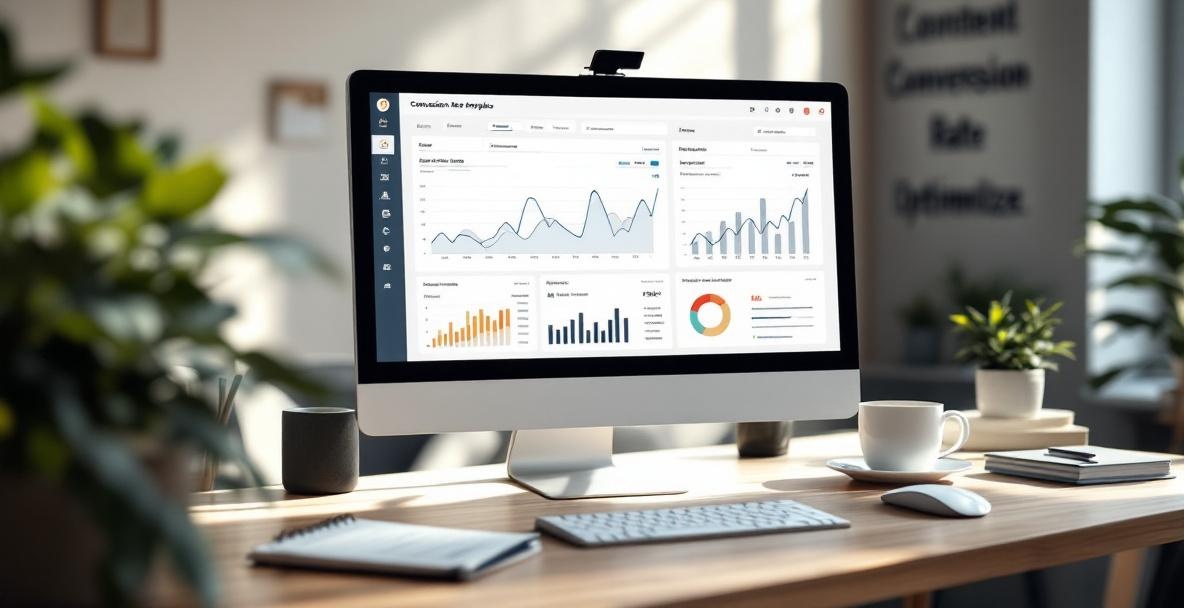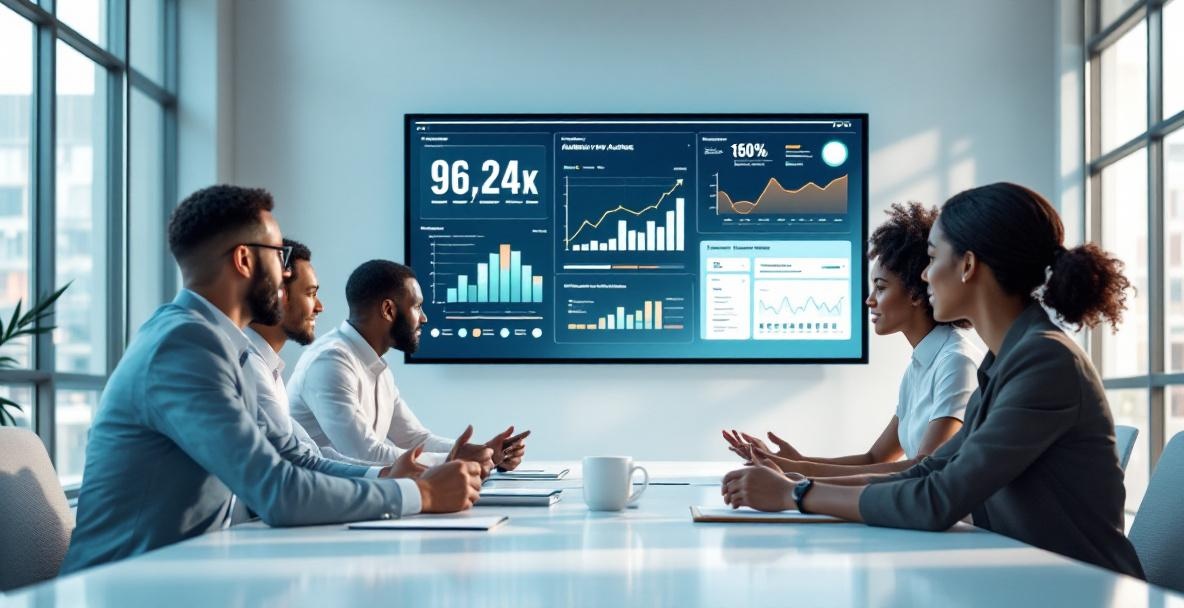Boost Your Conversions: Let's Crack the Code Together

Imagine your site drawing in thousands of visitors every month, yet only a few end up buying, signing up, or asking for more info. That gap between visits and real action is a challenge we deal with at SeoFlow on almost every project. Conversion rate optimization (CRO) is simply the process of nudging a higher percentage of your visitors to take the steps that matter, whether that means making a purchase or requesting a demo. By now, CRO is not a luxury-it’s a must-have strategy that can really boost your profits.
"Conversion rate optimization (CRO) is the systematic process of increasing the percentage of visitors who take desired actions on your website."
People online have become savvier and expect clear, smooth interactions. Sure, getting traffic with effective SEO content strategies is key, but what you do once visitors land on your page makes all the difference. This is where conversion rate optimization comes in-it turns casual browsers into engaged customers.
| What We Focus On | What We Aim To Achieve | Key Numbers We Watch | Tools & Tricks |
|---|---|---|---|
| Traffic Building | Bring quality visitors to your site | Organic sessions, paid clicks, click-through rate | SEO audits, keyword research, PPC campaigns, social media promotion |
| Boosting Conversions | Turn visitors into leads or customers | Conversion rate, average order value, funnel drop-offs | A/B testing tools, heatmaps, session recordings, UX tweaks |
Why You Can't Skip CRO in 2025
New visitors are expensive these days, so you need to make every visit count. With conversion rate optimization, you squeeze more value out of the traffic you already have, lowering costs and boosting revenue. At SeoFlow, we’ve seen that even a small bump in conversion rates can lead to big gains in profit-all without extra marketing dollars.
"Even modest gains in conversion rates can translate to significant wins in profitability without requiring additional marketing spend."
User habits have shifted dramatically. People now expect personalized experiences with quick, smooth interactions, and they won’t put up with confusing menus or slow pages. Using data-driven optimization techniques, businesses can create experiences that not only meet but exceed these high expectations, building loyalty when alternatives are just a click away.
| Metric | Before | After | Typical Gain |
|---|---|---|---|
| Overall Conversion Rate | 1.8% | 3.2% | +78% |
| Customer Acquisition Cost (CAC) | $120 | $75 | –37% |
| Average Order Value (AOV) | $85 | $92 | +8% |
| Revenue per Visitor (RPV) | $1.53 | $2.94 | +92% |
Beyond quick revenue boosts, effective CRO gives you precious insights into what drives your customers. Every test and tweak helps you understand your audience better, which then shapes not only your website design but also your overall marketing, product ideas, and content plans. Companies that combine CRO with smart SEO strategies often see a winning cycle: better engagement leads to higher search rankings, drawing in more visitors who are ready to convert.
Get to Know Your Visitors: The Key to More Conversions

Before fiddling with new design tricks, the real secret to boosting conversions is knowing your visitors. At SeoFlow, we know that when you take the time to understand your audience, your conversion rates naturally rise. When you know who you’re talking to, you can create experiences that resonate and make people feel truly valued. Let’s dive into how you can gather these insights and boost your conversion game.
"Buyer personas are semi-fictional profiles of your ideal customers created from real data and research."
Building Detailed Customer Profiles
These customer profiles go way beyond simple demographics; they reveal what drives your customers, the obstacles they face, and what goals they want to achieve. Start by examining your current customers closely-spot trends in behavior, likes, and buying decisions. Ask yourself: What problems are they trying to solve, and what might hold them back from converting?
| Data Type | What It Shows | How to Collect It | When to Apply |
|---|---|---|---|
| Qualitative Insights | Motivations, fears, language, emotional triggers | Customer interviews, open-ended surveys, usability tests | Crafting messaging, spotting objections, building personas |
| Quantitative Metrics | Scale of behaviors, funnel drop-offs, conversion percentages | Web analytics, heatmaps, A/B test results, CRM data | Prioritizing tests, validating ideas, measuring impact |
Talk to your current customers who represent your target groups. These conversations often reveal feelings and decision-making processes that numbers alone can miss. Speak with both your top customers and those who haven’t converted to get a full picture of the different groups and what really drives their decisions.
After you’ve gathered these insights, build 3 to 5 detailed profiles that include a name, job title, background details, goals, challenges, and preferred ways to connect. The best profiles even feature real quotes and specific examples that show exactly when they need your solution. These profiles become your roadmap-from setting the right tone on your site to choosing the data-driven strategies that drive better results.
Decoding User Behavior with Analytics
While these profiles give you the big picture, analytics tools supply the numbers that let you fine-tune your approach. Begin by picking the key stats that matter most to your conversion goals. Don’t just settle for overall conversion rates-look at micro-conversions, exit pages, time on page, and scroll depth to see where interest fades away.
Mapping out the user journey with analytics shows you exactly how visitors move before they either convert or bounce. Watch for common entry points, navigation paths, and exit pages to spot potential trouble areas. Tools like heat maps and session recordings reveal where users click, how far they scroll, and what grabs their attention, which can even change your SEO strategy by highlighting what needs improvement.
The best insights often come when you break down your data into segments that match your customer profiles. Compare how different groups behave to see what each one prefers. You might discover that while one group loves detailed product specs, another prefers emotional stories and social proof. By tweaking your approach for each group, you can design experiences that really boost conversions across the board.
Creating Content That Connects and Converts
Good content does more than just draw people in-it pushes them to take real action. At SeoFlow, we’ve learned that the secret is crafting content that grabs your readers and then gently guides them toward converting. The winning mix is content that offers real value while also encouraging action-a blend that calls for creativity backed by smart use of data. Let’s take a closer look at two key essentials for content that converts.
Writing Headlines That Grab You
Your headline is the first thing a visitor notices, and often it’s the only chance you get to hook them. We’ve seen firsthand that a strong headline can be the difference between a visitor staying or leaving. A great headline pulls readers in and sets the stage for everything that follows.
The best headlines tap into emotions-whether it’s sparking curiosity, creating a sense of urgency, or offering a clear solution. For example, using numbers like "7 Proven Ways To…" or "5-Minute Guide To…" tells readers exactly what they can expect and why it matters. Headlines that ask a question can hit just the right note and make people feel seen. Try out different headline styles until you find the one that really clicks with your crowd.
Designing Calls-to-Action That Click
Your call-to-action is the moment when a visitor decides whether to engage or move on. Through years of refining our strategies, we’ve learned that a solid CTA mixes a clear message with a nudge that inspires action. The best CTAs make you feel like you’re getting something valuable right away, without any added hassle.
Using active words such as "Get", "Start", "Discover", and "Unlock" shows benefits and drives action. Pair these with personal touches like "Your" to make each CTA feel tailor-made. Choosing a color that stands out from the rest of your design can also help draw the eye without clashing with your overall look. Where and when you place your CTA is just as important, so aim for a style that fits the visitor’s stage-maybe "Learn More" for newcomers instead of "Buy Now". Test different approaches and not only count clicks but also measure how well the engagement follows, because a great CTA leads to real, meaningful action.
Creating a Smooth Experience for Better Conversions
Good user experience is not just a trendy term; it’s what turns visitors into customers. We at SeoFlow know that even the best offers fall flat if your site is clunky or confusing. A smooth, clear experience removes obstacles that might otherwise drive potential customers away.
When your site feels easy to navigate and trustworthy, visitors are much more likely to act-whether that means subscribing, requesting a demo, or making a purchase. Clear navigation can really boost your conversion numbers. Use simple, relatable language in your menus and let your key CTAs stand out without cluttering the page. We’ve helped clients increase conversions by 30% just by reworking their menus and reducing too many choices, because every extra click or form field gives visitors a chance to back out.
Another smart trick is progressive disclosure. This means showing information bit by bit, rather than overwhelming visitors with everything at once. For example, breaking a long form into smaller, manageable steps makes it feel much easier to complete. This approach builds momentum and helps guide users smoothly toward conversion without overload.
Mobile Matters: Optimizing for Phone Users
These days, making your site mobile-friendly is a must if you want to boost conversions. Since most visitors now use mobile devices, ignoring this part of your strategy means losing a huge chunk of potential customers. Our data shows that mobile-optimized pages convert much better, sometimes boosting results by over 50% compared to sites that aren’t optimized.
Responsive design is only the beginning. A truly mobile-friendly site rethinks the entire user journey for small screens and touch interaction. What works on a desktop can turn into a headache on a phone, so we suggest testing your site on mobile to flag issues like tiny buttons, hard-to-use forms, or endless scrolling. These small hiccups add up fast and can really hurt your conversion numbers. Speed is especially crucial for mobile users, too; even a one-second delay can drop conversions by 7%. Using techniques like lazy loading, optimizing images, and trimming extra scripts can make a big difference. We’ve even helped clients set up AI-powered content delivery systems that adjust on the fly, ensuring faster load times and better engagement.
Testing and Tweaking: The Heart of Better Conversions

Even if your conversion ideas seem solid, testing and analyzing your efforts is key-you don’t want to rely on guesses. At SeoFlow, we know that real progress comes from making decisions based on data. Testing isn’t just a one-time step; it’s a continuous habit that powers every improvement you make. Let’s dive into some methods and tools that turn guesswork into clear, measurable action.
A/B Testing: Experimenting to See What Clicks
A/B testing, also known as split testing, is one of the best tools for boosting conversions. It means showing two different versions of a page or element to different groups of visitors to see which one works better. When you give version A to some visitors and version B to others, you learn which version helps you hit your goals more effectively.
Before you run an A/B test, have a clear idea based on what you know about your audience. For example, if you think a larger call-to-action could boost conversions, try a version with a bigger button and compare it with your current design. Focus on changing just one element-be it the headline, button color, form length, or image-so you know exactly what makes the difference. Patience is key here; let your test run until the results are statistically solid, even if it takes a few days or weeks. That extra time will pay off with reliable insights.
Making Sense of the Data for Ongoing Wins
Collecting data is just the start; the real work comes in understanding and using it. When you look at your results, don’t just check conversion rates-dig deeper into how long users stay on your page, where they bounce, and how they move through your site. Numbers like time on page and bounce rate add extra context to your conversion stats. Breaking your data into segments is really important too, since different groups respond in their own ways-a first-time visitor might love simplicity, while a returning customer might want more details. By digging into segmented data, you can find ways to tailor your approach for each group.
Remember, conversion optimization is a cycle. Every test you run should guide your next move. When something works, roll with it and keep improving. And if a test doesn’t work out or the results are fuzzy, see it as a learning chance rather than a failure. Sometimes the surprises are the best lessons. By staying data-driven, you can build a cycle of ongoing improvements that steadily boost your conversions.
If you’re ready to dive even deeper, check out the American Marketing Association’s on-demand resources for advanced tips, or explore the specialized CRO strategy courses from USC that focus on growth and customer care.
Final Thoughts: Elevate Your Conversion Rates
This guide shows that conversion rate optimization is more than just a marketing trick-it’s a fundamental shift that can change your business for the better. From truly knowing your visitors to crafting content that connects, smoothing out your user experience, and testing like a pro, CRO is a full-picture approach that boosts your online performance. At SeoFlow, we’ve seen these strategies not only lift conversion rates but also drive overall business growth and keep customers happy.
What sets the best apart is a systematic, thoughtful approach to conversion optimization. Use these strategies to rely on real data instead of guesses or outdated assumptions about your audience.
Next Steps: Let’s Get Started
Your journey to better conversions starts now, not when you finish reading. Begin by reviewing your current conversion funnel and spotting where customers are slipping away. Focus on one area first-maybe it’s a sharper landing page, a smoother checkout, or more compelling call-to-action buttons. Even small, strategic tweaks can lead to big improvements.
Keep in mind, CRO is a marathon, not a one-time sprint. Set aside time each month to review your data, brainstorm fresh ideas, and run tests. Consistency is key-top companies make CRO a core part of their strategy. And don’t be discouraged if some tests don’t hit the mark right away; every result, win or learn, tells you something valuable about your audience. Pair your testing with advanced SEO tactics for a real growth engine.
Ready to boost your conversion rates and grow your business? Try SeoFlow today to tap into our platform that not only fine-tunes your content for search engines but also fits perfectly into your conversion strategy. Our automated solutions help you create, schedule, and publish content that truly resonates and drives action, giving you more time to focus on growing your business.



